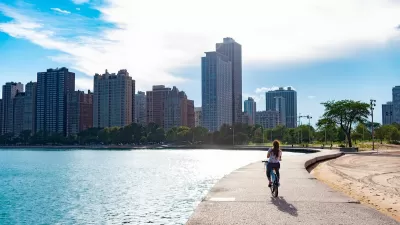Canadian researchers made the case at the Transportation Research Board this past week that improved bike infrastructure and neighborhood gentrification go hand in hand. They used research gathered fromi Portland and Chicago.
Researchers from the School of Urban Planning at McGill University and Université du Québec à Montréal "tried to quantify the connection between gentrification and cycling infrastructure," reports Emily Badger for Washington Post Wonkblog.
Cycling itself, as my colleague Perry Stein has written, has become a heated symbol of gentrification. Bike lanes are treated as harbingers of demographic change, or evidence of preferential treatment, or synonymous with well-off white men (all this, despite the fact that Census data shows low-income commuters are the most likely to bike).
["The people most likely to bike or walk to work are either the least educated in society or the most educated," wrote Badger on May 9, 2014 on the American Community Survey's findings.]
The researchers "mapped cycling infrastructure in Chicago and Portland alongside demographic change in neighborhoods between 1990 and 2010," writes Badger. "In both cities, they found "a bias towards increased cycling infrastructure in areas of privilege."
One sensitive issue was which comes first—the bike infrastructure or the changing demographics? Are new residents demanding bike infrastructure, or are wealthier, whiter, more educated residents attracted to bike-friendly neighborhoods? "The researchers sidestep the answer by suggesting that gentrification and cycling infrastructure 'mirror' each other in these two cities," writes Badger.
Check out the images mapping change in community composition, 1990-2010, showing cycling infrastructure in Chicago and Portland.
In Chicago, (n)eighborhoods with large white populations, or an influx of whites, were more likely to get these bike investments.
In both cities, denser neighborhoods closer to the center of town were more likely to have bike infrastructure.
Read how planners can address the pattern. To read the study, click here [25-page PDF].
Hat tip to Michael Keenly.
FULL STORY: Why bike lanes make people mad

Maui's Vacation Rental Debate Turns Ugly
Verbal attacks, misinformation campaigns and fistfights plague a high-stakes debate to convert thousands of vacation rentals into long-term housing.

Planetizen Federal Action Tracker
A weekly monitor of how Trump’s orders and actions are impacting planners and planning in America.

In Urban Planning, AI Prompting Could be the New Design Thinking
Creativity has long been key to great urban design. What if we see AI as our new creative partner?

Massachusetts Budget Helps Close MBTA Budget Gap
The budget signed by Gov. Maura Healey includes $470 million in MBTA funding for the next fiscal year.

Milwaukee Launches Vision Zero Plan
Seven years after the city signed its Complete Streets Policy, the city is doubling down on its efforts to eliminate traffic deaths.

Portland Raises Parking Fees to Pay for Street Maintenance
The city is struggling to bridge a massive budget gap at the Bureau of Transportation, which largely depleted its reserves during the Civd-19 pandemic.
Urban Design for Planners 1: Software Tools
This six-course series explores essential urban design concepts using open source software and equips planners with the tools they need to participate fully in the urban design process.
Planning for Universal Design
Learn the tools for implementing Universal Design in planning regulations.
Gallatin County Department of Planning & Community Development
Heyer Gruel & Associates PA
JM Goldson LLC
City of Camden Redevelopment Agency
City of Astoria
Transportation Research & Education Center (TREC) at Portland State University
Jefferson Parish Government
Camden Redevelopment Agency
City of Claremont




























